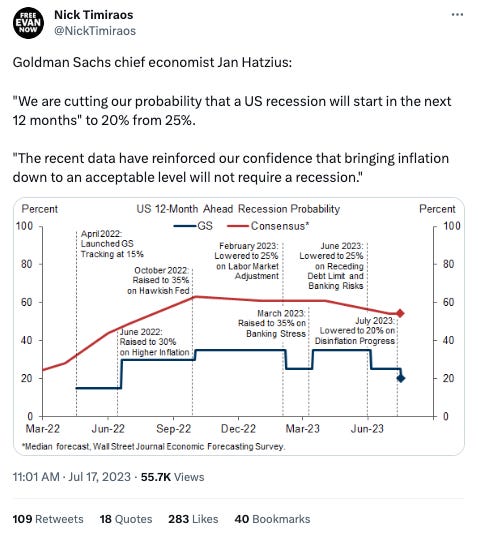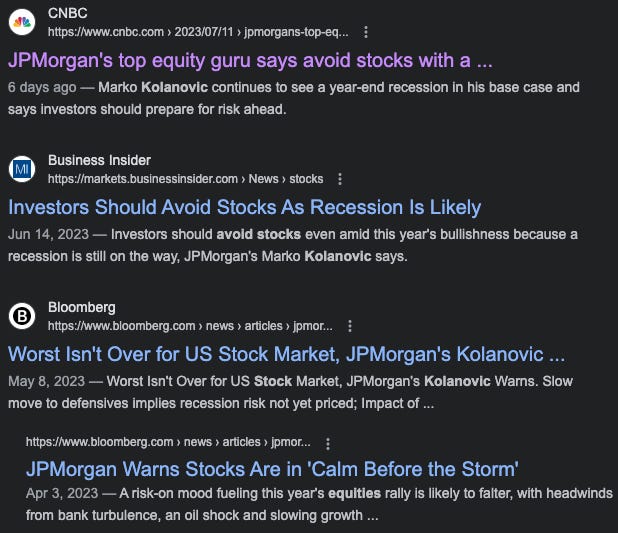💥Retail is a Sh*tshow, Again. Part II.💥
Mallinckrodt, Bed Bath & Beyond, Rite-Aid ($RAD), Arrival SA, Novan Inc. ($NOVN) + More
Can you feel the optimism? Check this ⬇️:
It seems that everyone is now hopping aboard Team Jerome POW-ell!
Isn’t he so dreamy?
Anyway, Goldman Sachs ($GS) isn’t the only place on Wall Street where people are starting to sing a new tune. Here is Bloomberg about JPMorgan Chase & Co.’s ($JPM) chief global markets strategist, Marko Kolanovic, who previously “…warned investors to shun equities amid looming economic risks…”:
…[Kolanovic] said the consumer price index for June has slightly increased the Federal Reserve’s chances of a “soft landing” — or taming inflation without triggering a downturn.
“While we still see the Fed hiking at the July meeting, the downside CPI surprise means a narrow path to a soft landing is modestly wider,” he wrote Monday in a note to clients.
Yes, this is the same guy:
Narrator: the S&P 500 Index is up nearly 10% since April 3, 2023, the date of the last link reflected above ⬆️. And it’s up 18.6% on the year as of July 21, 2023. So, 🖕Kolanovic, and welcome to the risk-on party, pal.
Not that all of the news this week has been good. China’s economy is in worrisome shape, growing “only” 6.3% YOY as the post-pandemic reopening there hasn’t lived up to expectations. US Treasury Secretary Janet Yellin doesn’t appear to think that China’s situation will reverberate too powerfully/negatively in the United States (and believes the US will avoid a recession):
Are you convinced?
The Conference Board isn’t. Its Leading Economic Index® (LEI) declined by 0.7% in June, following a 0.6% decline in May. The LEI is down 4.2% over the past six months:
"The U.S. LEI fell again in June, fueled by gloomier consumer expectations, weaker new orders, an increased number of initial claims for unemployment, and a reduction in housing construction," said Justyna Zabinska-La Monica, Senior Manager, Business Cycle Indicators, at The Conference Board. "The Leading Index has been in decline for fifteen months—the longest streak of consecutive decreases since 2007-08, during the runup to the Great Recession. Taken together, June's data suggests economic activity will continue to decelerate in the months ahead. We forecast that the US economy is likely to be in recession from Q3 2023 to Q1 2024. Elevated prices, tighter monetary policy, harder-to-get credit, and reduced government spending are poised to dampen economic growth further."
Nothing like callbacks to the Great Recession to get restructuring pros all hot and heavy.
Here, too, is Moody’s raining on Ms. Yellin’s and everyone’s — well everyone who isn’t a restructuring professional — parade:
Defaults last month sent the global speculative-grade default rate to 3.8% for the 12-month period ended in June, up from 3.6% at the end of May. Moody’s Investors Service expects the rate to trend higher over the remainder of 2023, finishing at 4.7% in December. In 2024, we expect the rate to peak at 5.1% in March before easing to 4.6% in June. High interest rates together with tight lending conditions have significantly raised borrowing and refinancing costs and will increasingly constrain aggregate demand. Sluggish revenue and cash-flow growth in the slowing economy and higher debt repayment costs will in turn increase companies' debt-service burdens. Low-rated companies will find it difficult to meet refinancing and liquidity needs and therefore face heightened default risk in the current economic environment. Interest rates are likely to remain high, with the Fed maintaining a tight monetary policy stance this year to facilitate further steady disinflation to the central bank’s target. Moody’s Investors Service’s baseline forecasts incorporates assumptions that the U.S. high-yield spread will widen to 526 bps over the next four quarters from about 390 bps at the end of June, and that the U.S. unemployment rate will rise to 4.9% from 3.6% in the comparable period. (emphasis added)
Apparently Cleary Gottlieb Steen & Hamilton LLP’s Richard Cooper’s phone would agree. Per Bloomberg:
Richard Cooper’s phone is something of an early alarm bell for the global economy. Lately, it’s been ringing a lot.
A partner at Cleary Gottlieb, a top law firm for corporate bankruptcies, he’s advised businesses worldwide for decades on what to do when they’re drowning in debt. He did it through the global financial crisis, the oil bust in 2016 and Covid-19. And he’s doing it again now, in a year when big corporate bankruptcies are piling up at the second-fastest pace since 2008, eclipsed only by the early days of the pandemic.
“It feels different than prior cycles,” Cooper said. “You’re going to see a lot of defaults.”
His perch has given him a preview of the more than $500 billion storm of corporate-debt distress that’s already starting to make landfall across the globe, according to data compiled by Bloomberg. The tally is all but certain to grow. And that’s deepening worries on Wall Street by threatening to slow economic growth and strain credit markets just emerging from the deepest losses in decades.
Where is a lot of this troubled debt?






